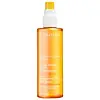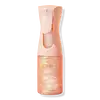What's inside
What's inside
 Key Ingredients
Key Ingredients

 Benefits
Benefits

 Concerns
Concerns

 Ingredients Side-by-side
Ingredients Side-by-side

C12-15 Alkyl Benzoate
AntimicrobialAlcohol
AntimicrobialOctyldodecanol
EmollientHomosalate
Skin ConditioningOctocrylene
UV AbsorberButyloctyl Salicylate
Skin ConditioningButyl Methoxydibenzoylmethane
UV AbsorberEthylhexyl Salicylate
UV AbsorberPolyester-7
Skin ConditioningNeopentyl Glycol Diheptanoate
EmollientTriisostearin
Skin ConditioningCalophyllum Inophyllum Seed Oil
AntimicrobialParfum
MaskingTocopheryl Acetate
AntioxidantBenzyl Salicylate
PerfumingTocopherol
AntioxidantEthylene Brassylate
MaskingLimonene
PerfumingButylphenyl Methylpropional
PerfumingAloe Barbadensis Leaf Juice
Skin ConditioningButylene Glycol
HumectantGlycerin
HumectantHelianthus Annuus Seed Oil
EmollientWater
Skin ConditioningHexyl Cinnamal
PerfumingCitronellol
PerfumingCassia Alata Leaf Extract
AstringentPhenoxyethanol
PreservativePlatanus Occidentalis Bark Extract
Skin ProtectingCitric Acid
BufferingPotassium Sorbate
PreservativeSodium Benzoate
MaskingC12-15 Alkyl Benzoate, Alcohol, Octyldodecanol, Homosalate, Octocrylene, Butyloctyl Salicylate, Butyl Methoxydibenzoylmethane, Ethylhexyl Salicylate, Polyester-7, Neopentyl Glycol Diheptanoate, Triisostearin, Calophyllum Inophyllum Seed Oil, Parfum, Tocopheryl Acetate, Benzyl Salicylate, Tocopherol, Ethylene Brassylate, Limonene, Butylphenyl Methylpropional, Aloe Barbadensis Leaf Juice, Butylene Glycol, Glycerin, Helianthus Annuus Seed Oil, Water, Hexyl Cinnamal, Citronellol, Cassia Alata Leaf Extract, Phenoxyethanol, Platanus Occidentalis Bark Extract, Citric Acid, Potassium Sorbate, Sodium Benzoate
Butyl Methoxydibenzoylmethane 3%
UV AbsorberHomosalate 0.5%
Skin ConditioningEthylhexyl Salicylate 5%
UV AbsorberOctocrylene 10%
UV AbsorberAlcohol Denat.
AntimicrobialC12-15 Alkyl Benzoate
AntimicrobialButyloctyl Salicylate
Skin ConditioningDiisopropyl Adipate
EmollientSodium Hyaluronate
HumectantTocopherol
AntioxidantHydrogenated Castor Oil
EmollientTetrahexyldecyl Ascorbate
AntioxidantRicinus Communis Seed Oil
MaskingDicaprylyl Carbonate
EmollientVa/Butyl Maleate/Isobornyl Acrylate Copolymer
Parfum
MaskingMica
Cosmetic ColorantT-Butyl Alcohol
PerfumingTin Oxide
AbrasiveHexyl Cinnamal
PerfumingBenzyl Salicylate
PerfumingLinalool
PerfumingCI 77891
Cosmetic ColorantCI 77491
Cosmetic ColorantButyl Methoxydibenzoylmethane 3%, Homosalate 0.5%, Ethylhexyl Salicylate 5%, Octocrylene 10%, Alcohol Denat., C12-15 Alkyl Benzoate, Butyloctyl Salicylate, Diisopropyl Adipate, Sodium Hyaluronate, Tocopherol, Hydrogenated Castor Oil, Tetrahexyldecyl Ascorbate, Ricinus Communis Seed Oil, Dicaprylyl Carbonate, Va/Butyl Maleate/Isobornyl Acrylate Copolymer, Parfum, Mica, T-Butyl Alcohol, Tin Oxide, Hexyl Cinnamal, Benzyl Salicylate, Linalool, CI 77891, CI 77491
Ingredients Explained
These ingredients are found in both products.
Ingredients higher up in an ingredient list are typically present in a larger amount.
Benzyl Salicylate is a solvent and fragrance additive. It is an ester of benzyl alcohol and salicylic acid. This ingredient can be naturally found in some plants and plant extracts.
In fragrances, Benzyl Salicylate may be a solvent or a fragrance component. In synthetic musk scents, it is used as a solvent. For floral fragrances such as lilac and jasmine, it is used as a fragrance component. The natural scent of Benzyl Salicylate is described as "lightly-sweet, slightly balsamic".
While Benzyl Salicylate has been associated with contact dermatitis and allergies, emerging studies show it may not be caused by this ingredient alone.
However, this ingredient is often used with fragrances and other components that may cause allergies. It is still listed as a known allergen in the EU. We recommend speaking with a professional if you have concerns.
Another study from 2021 shows Benzyl Salicylate may have anti-inflammatory properties.
Learn more about Benzyl SalicylateAlso known as Avobenzone, this ingredient is a chemical sunscreen filter that provides protection in the UV-A range.
Avobenzone is globally approved and is the most commonly used UV-A filter in the world.
Studies have found that avobenzone becomes ineffective when exposed to UV light (it is not photostable; meaning that it breaks down in sunlight). Because of this, formulations that include avobenzone will usually contain stabilizers such as octocrylene.
However, some modern formulations (looking at you, EU!) are able to stabilize avobenzone by coating the molecules.
Avobenzone does not protect against the UV-B range, so it's important to check that the sunscreen you're using contains other UV filters that do!
The highest concentration of avobenzone permitted is 3% in the US, and 5% in the EU.
Learn more about Butyl MethoxydibenzoylmethaneButyloctyl Salicylate is a chemical UV filter structurally similar to octisalate. It is a photostabilizer, SPF booster, emollient and solvent. This ingredient helps evenly spread out ingredients.
According to a manufacturer, it is suitable for pairing with micro Titanium Dioxide, Zinc Oxide, and pigments.
Photostabilizers help stabilize UV-filters and prevents them from degrading quickly.
Learn more about Butyloctyl SalicylateC12-15 Alkyl Benzoate is made up of Benzoic Acid and long chain alcohols. It has a low molecular weight.
C12-15 Alkyl Benzoate is an emollient and texture enhancer. Due to its solubility, it is often used in sunscreens to help evenly distribute active ingredients.
As an emollient, C12-15 Alkyl Benzoate helps soften and hydrate your skin. Emollients create a film on your skin that traps moisture within.
This ingredient has been reported to cause eye irritation.
Learn more about C12-15 Alkyl BenzoateEthylhexyl Salicylate is an organic compound used to block UV rays. It primarily absorbs UVB rays but offers a small amount of UVA protection as well.
Commonly found in sunscreens, Ethylhexyl Salicylate is created from salicylic acid and 2-ethylhexanol. You might know salicylic acid as the effective acne fighter ingredient and BHA.
The ethylhexanol in this ingredient is a fatty alcohol and helps hydrate your skin, similar to oils. It is an emollient, which means it traps moisture into the skin.
According to manufacturers, Ethylhexyl Salicylate absorbs UV wavelength of 295-315 nm, with a peak absorption at 307-310 nm. UVA rays are linked to long term skin damage, such as hyperpigmentation. UVB rays emit more energy and are capable of damaging our DNA. UVB rays cause sunburn.
Learn more about Ethylhexyl SalicylateHexyl Cinnamal is a fragrance ingredient with a similar scent to jasmine. It can be naturally found in chamomile essential oil.
This ingredient is a known EU allergen and may sensitize the skin. The EU requires this ingredient to be listed separately on an ingredients list.
Hexyl Cinnamal is not water soluble but is soluble in oils.
Learn more about Hexyl CinnamalHomosalate is a chemical sunscreen filter that provides protection in the UV-B range (280nm - 320 nm), with a peak protection at 306 nm. It is internationally approved for use in sunscreens.
Homosalate is not photo-stable, meaning it's strength as a UV filter degrades over time with exposure to the sun. Because of this, it's often used in combination with other chemical sunscreen filters as avobenzone (which protects from the UV-A range). Homosalate also helps act as a solvent for harder-to-dissolve UV filters.
(Part of the reason that sunscreens need to be frequently re-applied is due to the photo instability of many chemical sunscreen filters)
Currently, homosalate is approved in concentrations up to 10% in the EU and 15% in the US. The FDA is currently doing further research on the effects of homosalate, and it is possible that these approved concentrations will change in the future.
Learn more about HomosalateOctocrylene protects skin from sun damage. It absorbs UV-B with peak absorption of 304 nm. It is a common sunscreen ingredient and often paired with avobenzone, a UVA filter. This is because octocrylene stabilizes other sunscreen ingredients by protecting them from degradation when exposed to sunlight. Octocrylene is a photostable ingredient and loses about 10% of SPF in 95 minutes.
Octocrylene also acts as an emollient, meaning it helps skin retain moisture and softens skin. It is oil-soluble and hydrophobic, enhancing water-resistant properties in a product.
Those who are using ketoprofen, a topical anti-inflammatory drug, may experience an allergic reaction when using octocrylene. It is best to speak with a healthcare professional about using sunscreens with octocrylene.
The EU allows a maximum of these concentrations:
Learn more about OctocryleneParfum is a catch-all term for an ingredient or more that is used to give a scent to products.
Also called "fragrance", this ingredient can be a blend of hundreds of chemicals or plant oils. This means every product with "fragrance" or "parfum" in the ingredients list is a different mixture.
For instance, Habanolide is a proprietary trade name for a specific aroma chemical. When used as a fragrance ingredient in cosmetics, most aroma chemicals fall under the broad labeling category of “FRAGRANCE” or “PARFUM” according to EU and US regulations.
The term 'parfum' or 'fragrance' is not regulated in many countries. In many cases, it is up to the brand to define this term.
For instance, many brands choose to label themselves as "fragrance-free" because they are not using synthetic fragrances. However, their products may still contain ingredients such as essential oils that are considered a fragrance by INCI standards.
One example is Calendula flower extract. Calendula is an essential oil that still imparts a scent or 'fragrance'.
Depending on the blend, the ingredients in the mixture can cause allergies and sensitivities on the skin. Some ingredients that are known EU allergens include linalool and citronellol.
Parfum can also be used to mask or cover an unpleasant scent.
The bottom line is: not all fragrances/parfum/ingredients are created equally. If you are worried about fragrances, we recommend taking a closer look at an ingredient. And of course, we always recommend speaking with a professional.
Learn more about ParfumTocopherol (also known as Vitamin E) is a common antioxidant used to help protect the skin from free-radicals and strengthen the skin barrier. It's also fat soluble - this means our skin is great at absorbing it.
Vitamin E also helps keep your natural skin lipids healthy. Your lipid skin barrier naturally consists of lipids, ceramides, and fatty acids. Vitamin E offers extra protection for your skin’s lipid barrier, keeping your skin healthy and nourished.
Another benefit is a bit of UV protection. Vitamin E helps reduce the damage caused by UVB rays. (It should not replace your sunscreen). Combining it with Vitamin C can decrease sunburned cells and hyperpigmentation after UV exposure.
You might have noticed Vitamin E + C often paired together. This is because it is great at stabilizing Vitamin C. Using the two together helps increase the effectiveness of both ingredients.
There are often claims that Vitamin E can reduce/prevent scarring, but these claims haven't been confirmed by scientific research.
Learn more about Tocopherol